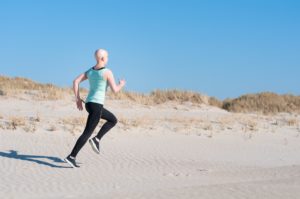Client Handouts/Tips for Clients
The Pancreas: Two Glands in One
Located behind the stomach in the upper abdomen, the pancreas is a glandular organ that has two primary “jobs.” It is both a digestive exocrine gland (secreting products via ducts) and a hormone-producing endocrine gland (secreting substances directly into the bloodstream). The pancreas excretes enzymes to break down the foods we eat, and it secretes insulin and glucagon to control blood sugar (Taylor 2018). Spongy, and shaped like a flat pear, it’s about 6–10 inches long (Columbia University Medical Center 2018).
High-Intensity Interval Training for Fat Loss
Two recent studies reveal that high-intensity interval training has the ability to produce high-impact fitness gains in a short time frame.
Physical Activity Can Reduce Burnout
Burnout is an issue in the modern world, with annual costs to society estimated at more than $136 billion. Physical activity can reduce the risk of burnout, defined as a severe and persistent form of fatigue that occurs after a long period of work stress.
Options that reduce professional burnout are good news for employers. Fitness pros who want to promote corporate wellness can share the following study with business owners to highlight the benefits of onsite fitness programs.
Activity Tracker Usage Improves
The initial finding—that people stop using their fitness trackers after the first 6 months—seems to be evolving. In a new study by insurance company Humana, 80% of participants in a structured program were still using activity trackers after 6 months. Researchers at the Perelman School of Medicine at the University of Pennsylvania in Philadelphia found that game design elements—such as points, levels, badges and financial incentives—helped to keep users active.
Bone Loss: A Primer
Bone loss is a normal part of aging, and understanding it can help fitness professionals to develop preventive strategies for their clients.
Corporate Fitness Evolves
Employers are looking for partners to provide experiences and solutions in social, emotional, financial, family and career growth and well-being,” says Grace DeSimone, national group fitness director with Plus One Health Management, an Optum company, in New York City. Companies are also embracing mindfulness, meditation and virtual solutions for telecommuting employees, according to DeSimone. All these changes represent an evolution from programs aimed primarily at improving physical health and controlling healthcare costs.
NEAT Exercise for the Brain
Have you heard that prolonged sitting can be as bad for health as smoking (Owen, Bauman & Brown 2008)? The good news is that movement can help, and it doesn’t have to be a marathon. One avenue worth exploring is nonexercise activity thermogenesis (NEAT). NEAT encompasses the calories burned while living life: walking to work, fidgeting, typing, folding clothes, washing dishes, running errands and so on; only sleeping, eating and sports are not included (Levine & Yeager 2009).
Center of Attention: 4 Strategies for High-Intensity Mental Training
Ours is a world wired for distraction. Online information and social media constantly compete for our attention, thwarting efforts to focus on a single goal. The results are scattered thoughts, shorter attention spans and a rewiring of our brains, all of which prevent us from performing at our very best in whatever we do. For many of us, multitasking—focusing on several targets at once—may seem like the obvious solution. However, performance generally decreases in multitaskers by as much as 40% (Schwartz & Goldstein 2017).
Best Foot Forward
A challenging beginning. Ezra didn’t have an easy start. Born with club feet—a congenital condition in which the foot is twisted out of shape or position—he had his first surgery shortly after birth and spent the first few years of life sleeping with corrective boots.
Spotting and Fixing Flaws in Walking Biomechanics
Participating in a program of regular exercise is a good idea at any stage of life, but particularly as we get older. Exercising frequently and consistently has many documented benefits, including promoting good health, preventing disease, enhancing mental health and physical capacity, aiding recovery from injury and illness, minimizing the effects of aging, and improving one’s ability to handle the physical demands of life (Bird, Smith & James 1998).
Exercise Doesn’t Have To Be Strenuous To Be Effective
We know that replacing sedentary behavior with physical activity yields numerous benefits. And while high-intensity models are touted as a way to fast-track success, a new study out of Sweden says it’s not necessary to go all-out in order to boost health.
Helpful Productivity Apps
Do you struggle to stay focused or cross off items on your to-do list? There are apps for that. Here, five successful business owners share their favorite apps for getting things done:
A New Way to Combat High Blood Pressure During Menopause
Researchers have linked menopause with arterial stiffness and high blood pressure. A recent study of Korean women, led by The North American Menopause Society, suggests that taking the stairs is a good way to manage those conditions.
The Best Exercise for Alzheimer’s Disease
If you were asked to choose among cardiovascular exercise, resistance training and a combination of both to help people with Alzheimer’s disease, what choice would you make?
Researchers from the University of Connecticut wanted to understand the effects of exercise—if any—on cognitive decline in those at risk of or diagnosed with Alzheimer’s. The scientists performed a meta-analysis of 19 studies (23 exercise interventions) featuring 1,145 adults aged 77 ± 7.5 years.
Secrets of Muscle Growth
Muscle growth is often a goal for people seeking guidance from qualified fitness professionals. Recently, researchers from the University of Cumbria in Lancaster, England, reviewed relevant scientific papers to find best practices for achieving that goal.
The review authors looked at several primary factors associated with muscle hypertrophy: training volume, load, training frequency, training to momentary muscle failure, exercise variation, contraction type, exercise order, repetition tempo and interest recovery. Here’s a sampling of the conclusions:
9 Simple Ways to Keep Your Clients
The success of your business relies solely on your ability to attract and keep clients. Use these tips to enhance the client-trainer relationship so that you can focus more on providing quality service to your current clients and less on finding new ones.
7 Keys to Creating an Unforgettable Onboarding Experience
Do you want to strategically and consistently educate and motivate your new clients so they feel like they’re getting incredible results—and so you’re getting a steady flow of referrals and earning positive social proof? Are you ready to not just deliver but over-deliver? If your answer is yes, then one of your most important next moves is to create a step-by-step onboarding process.
Learn, Connect and Thrive at the IDEA® World Convention
Education is the foundation of the IDEA World Convention, but this fitness event offers plenty more than stellar instruction. For Jonathan Bernath, publicist-turned-personal-trainer, it’s where he discovered the “fitness family” that would guide him in his new career.
Strength Training May Increase Life Span
Here’s more motivation for clients to add strength exercises to their fitness programs: New research shows that strength training plays an important role in reducing risk of premature death from all causes and, specifically, from cancer—and when it comes to cancer, strength work may be even more beneficial to health than aerobic training.
Shoulder Blades: The Right Moves
The shoulder blades, or scapulae, are critical links in the kinetic chain from the waist through the shoulders, up to the neck and down to the fingertips. Abnormalities in the position or movement of the shoulder blades—technically called scapular dyskinesis—can trigger pain and discomfort, especially among people who spend long hours sitting and using computers.


















